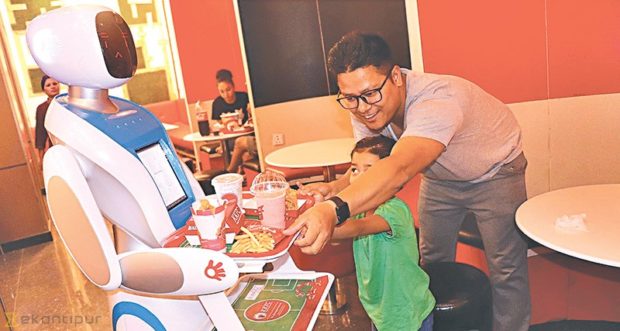
KATHMANDU — Restaurants need to do more than serve tasty and quality food if they want to stay in business, they have to adopt new business strategies as competition is intensifying.
The players in the industry have to make efforts to keep up with the changing tastes of customers, and they are constantly innovating to stay a step ahead of their competitors. The latest bright idea is to have robots serve food to customers. Diners let their jaw drop when they see sci-fi characters as waiters. Moreover, they can save on the 10 percent service charge because the machines are not unionized.
Krispy Krunchy Fried Chicken (KKFC) at People’s Plaza, Khichapokharai is the first restaurant in the country to employ robots. Established with an investment of Rs30 million, KKFC plans to open outlets at Civil Mall, Sundhara and at Maitidevi later this month. KKFC has three robot waiters.
“Nepali people love food. The fast-growing restaurant market in Kathmandu is a result of the growing trend of eating out,” said Amar Shah, the founder of KKFC. Shah completed his studies in Australia. After gaining experience in the business, he returned to Nepal and started the restaurant where robots serve food to wide-eyed customers.
Shah said that innovation and technology is what grows a business in the present context. A year after the launch of KKFC, he is already preparing to open two other outlets with an investment of Rs10.5 million. The Maitidevi outlet will use self-service kiosk technology, again another first in Nepal’s restaurant business. It consists of an interactive kiosk and a computer terminal which allows customers to order from the restaurant’s catalogue.
Naulo Restaurant on Durbar Marg has five robot waiters. Restaurants have been adding modern services to add value to their services in recent years, said Pramod Jaiswal, president of the Restaurant and Bar Association of Nepal (REBAN). “Young entrepreneurs are attracted to the lucrative restaurant business. The new generation also comes with something extra and unique ideas.”
Red Mud Coffee in Jhamsikhel has human waiters, but they don’t write down your order in a notebook. They use a tablet and your order is sent instantly to the kitchen. It has been a paperless restaurant for the past six years.
Apart from technology, the ambience of a restaurant is another important factor that affects its profitability. Kings Lounge on Durbar Marg, opened with an investment of around Rs80 million, has gained popularity in a short span of time due to its unique decor. “As the name suggests, we have tried to provide the royal theme to our customers,” said Kumar Gurung, owner and founder of Kings Lounge.
The restaurant has sections with different themes such as sports and coffee. The habit of dining out with family and friends has increased significantly, said Gurung. “People have realized that one should spend quality time with family and friends.”
The burgeoning middle class is another reason behind the growing restaurant business. Different places in the Kathmandu Valley are emerging as food hubs. Not too long ago, Thamel, New Road and Durbar Marg were the places people went to when they wanted to dine in a restaurant.
Today, Jhamsikhel is a popular food hub. Naxal, Bhat Bhateni, Baluwatar, Lazimpat, Maharajgunj, New Baneshwor, Jawalakhel and Kumaripati are other food destinations in Kathmandu. Nagpokhari and Bhainsepati are up-and-coming places to eat. The restaurants here not only offer delicious dishes, they provide a pleasant atmosphere. Shopping malls are other great places to eat. With the opening of new malls and cinema halls, the fast food business has automatically grown around those places.
According to Jaiswal, there are around 6,000 restaurants and bars, fast food cafes and food outlets in the Valley. You need to spend a minimum of Rs20 million to open a 50-100 capacity standard restaurant as the kitchen equipment alone costs at least Rs5 million, said Jaiswal.